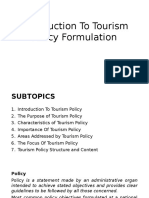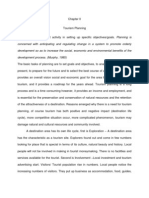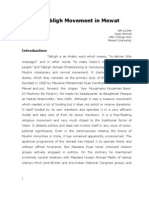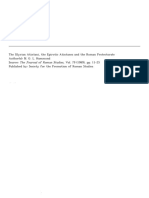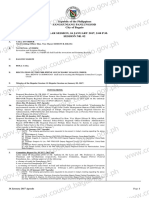Final Print
Final Print
Uploaded by
Cynexs RomeroCopyright:
Available Formats
Final Print
Final Print
Uploaded by
Cynexs RomeroCopyright
Available Formats
Share this document
Did you find this document useful?
Is this content inappropriate?
Copyright:
Available Formats
Final Print
Final Print
Uploaded by
Cynexs RomeroCopyright:
Available Formats
Lalu, Jaymar D.
BSHRM-3b
1. Brief history of tourism development Thomas Cook took the first tourists to Paris in 1855. On the return journey, gathering for the buses / coaches some people got arrested for waiting in the park. In Paris people were not allowed to have gatherings. His first excusion was Leicester to Loughborough in 1841. Prior to 1834, the Bank of England observed about thirty-three saints' days and religious festivals as holidays, but in 1834, this was reduced to just four: 1 May, 1 November, Good Friday, and Christmas Day. In 1871, the first legislation relating to bank holidays
Transport Network: Air travel for the mass market - cheap and available Ferry routes competing with air transport Growth of motorway network Technological Change: Mass produced consumer products Mass produced cars Falling costs of the above Development of Internet and e-commerce Socio-Economic Development: Higher incomes Stable low inflation Greater amount of leisure time Greater mobility
2. Why do we need to develop tourism? The reasons for developing tourism, for example: - Economic - increasing income, employment, foreign exchange, government revenues and using tourism to boost other sectors - Socio-cultural - social reasons, such as cross-cultural exchange, educating people, providing recreation opportunities - Environmental - to achieve environmental and cultural conservation objectives - Technological - provision of infrastructure needed for tourism, where considered unprofitable by private sector
3. What is tourism planning? Tourism planning is goal-oriented, striving to achieve certain objectives by matching available resources and programs with the needs and wants of people. Comprehensive planning requires a systematic approach, usually involving a series of steps. The process is best viewed as an iterative and ongoing one, with each step subject to modification and refinement at any stage of the planning process. 4. What is tourism planning process? The planning process regards the environment which includes political, physical, social and economic elements as interrelated and interdependent components which should be taken into account in considering the future of a destination. There are six steps in the planning process: 1. Define goals and objectives. 2. Identify the tourism system. a) Resources b) Organizations c) Markets 3. Generate alternatives. 4. Evaluate alternatives. 5. Select and implement. 6. Monitor and evaluate.
5. What is the planning policy? Planning policy is used to help determine planning applications - what can be built, where, and how buildings are used. It is also used to plan strategically, looking at future needs to be addressed, what change is likely to happen and where, and what policies are needed to achieve this. Planning policy exists at the national, regional (London) and local level.
Reasons for Tourism Planning This guidance, to be read alongside national planning policies, is designed to: Ensure that planners understand the importance of tourism and take this fully into account when preparing development plans and taking planning decisions Ensure that those involved in the tourism industry understand the principles of national planning policy as they apply to tourism and how these can be applied when preparing individual planning applications and Ensure that planners and the tourism industry work together effectively to facilitate, promote and deliver new tourism development in a sustainable way
6. Differentiate international, domestic and national tourism. Domestic tourism would be touring one's own country. International tourism meaning attracting other nation's resident or citizen to visit the country. National tourism is attracting your own citizen to travel.
You might also like
- Written Assignment Pad104Document17 pagesWritten Assignment Pad104Aqie Aqlh100% (1)
- Side by Side 1 Test 2Document3 pagesSide by Side 1 Test 2nlucy2226100% (1)
- TPC-4 - Tourism Policy Planning and Development - HandoutDocument18 pagesTPC-4 - Tourism Policy Planning and Development - HandoutKaren100% (3)
- Tourism Policy and Planning NotesDocument37 pagesTourism Policy and Planning NotesAli Asraf50% (2)
- 2.2 Approaches To Tourism PlanningDocument29 pages2.2 Approaches To Tourism PlanningAnonymous LpBeanyhM75% (8)
- TOPIC 1 Introduction To Tourism PolicyDocument26 pagesTOPIC 1 Introduction To Tourism PolicyMalik Mohamed75% (12)
- Travel Fast or Smart?: A Manifesto for an Intelligent Transport PolicyFrom EverandTravel Fast or Smart?: A Manifesto for an Intelligent Transport PolicyNo ratings yet
- And Encompasses A Growing Number of New Destinations. These Dynamics Have Turned Tourism Into A Key Driver For Socio-Economic Progress."Document4 pagesAnd Encompasses A Growing Number of New Destinations. These Dynamics Have Turned Tourism Into A Key Driver For Socio-Economic Progress."Nileth MartinezNo ratings yet
- TM125 ReviewerDocument5 pagesTM125 Reviewerpaul.sansanoNo ratings yet
- Tourism PolicyDocument45 pagesTourism Policyfiguracion.noviemelNo ratings yet
- TTP ASSESMENT TOOLS - Google DocsDocument7 pagesTTP ASSESMENT TOOLS - Google DocsJinel UyNo ratings yet
- TourismPlanningImportance, Benefits, Types&Levels 1685893415124Document6 pagesTourismPlanningImportance, Benefits, Types&Levels 1685893415124samuel OseiNo ratings yet
- Community Based Tourism PlanningDocument43 pagesCommunity Based Tourism PlanningMalik MohamedNo ratings yet
- Tourism Planning Basic Concepts Approaches and Techniques 2Document42 pagesTourism Planning Basic Concepts Approaches and Techniques 2janelleallab15No ratings yet
- 8 Approaches That Should Be Practiced While Studying TourismDocument4 pages8 Approaches That Should Be Practiced While Studying TourismEugenia ThienNo ratings yet
- Tourism SpotsDocument13 pagesTourism SpotsPraveenNo ratings yet
- Community Based Tourism PlanningDocument34 pagesCommunity Based Tourism PlanningMalik Mohamed100% (3)
- Tourism PlanningDocument5 pagesTourism PlanningAngel Grace LargoNo ratings yet
- Factors Affecting Food Ways and Culinary PracticesDocument8 pagesFactors Affecting Food Ways and Culinary PracticesRegie Atienza50% (4)
- TextDocument3 pagesTextsenguptasanjib771No ratings yet
- International Tourism Policy and Development Introductory - Tourism & Hospitality ManagementDocument17 pagesInternational Tourism Policy and Development Introductory - Tourism & Hospitality ManagementmlstoredubaiNo ratings yet
- Tourism Planning - Basic Concepts, Approaches, and TechniquesDocument44 pagesTourism Planning - Basic Concepts, Approaches, and TechniquesGeline JoseNo ratings yet
- Week 1 Tourism in PerspectiveDocument53 pagesWeek 1 Tourism in PerspectiveMinh Nguyễn ĐăngNo ratings yet
- TPC 4 Tourism Policy Planning and Development HandoutDocument19 pagesTPC 4 Tourism Policy Planning and Development HandoutbhowalchitralekhaNo ratings yet
- Introduction To Sustainable TourismDocument6 pagesIntroduction To Sustainable TourismJanella LlamasNo ratings yet
- Tourism Planning PDFDocument22 pagesTourism Planning PDFNaiem Nawshad Al RefatNo ratings yet
- Chapter 4 Tourism Planning and DevelopmentDocument57 pagesChapter 4 Tourism Planning and DevelopmentJanine Resos75% (4)
- Trends and Issues in Hospitality WK 1-4Document33 pagesTrends and Issues in Hospitality WK 1-4Shaira Grace AldayNo ratings yet
- Tourism Planning CH 3Document39 pagesTourism Planning CH 36tpnwtfmzyNo ratings yet
- Tourism PlanningDocument37 pagesTourism PlanningCristel Anne A. LlamadorNo ratings yet
- 08 Chapter 02 PDFDocument42 pages08 Chapter 02 PDFkumara deepanNo ratings yet
- Who Plans For The FutureDocument27 pagesWho Plans For The FutureKennieth Buyan MendozaNo ratings yet
- Levels, Type and Process of Planning: 1. Learning OutcomesDocument45 pagesLevels, Type and Process of Planning: 1. Learning OutcomesArunRajNo ratings yet
- Tourism Planning: ©ramakrishna KongallaDocument49 pagesTourism Planning: ©ramakrishna KongallaAr Komal MehtaNo ratings yet
- 1Document15 pages1ParulNo ratings yet
- TourismDocument60 pagesTourismMinh Nguyễn ĐăngNo ratings yet
- Unit 1Document8 pagesUnit 1Josephine Victoria PazNo ratings yet
- Tourism PlanningDocument5 pagesTourism PlanningDesriviere27No ratings yet
- Contemporary To Hospitality and Tourism Services Quarter 1 - Week 1Document12 pagesContemporary To Hospitality and Tourism Services Quarter 1 - Week 1Kia LagramaNo ratings yet
- Handouts For Tourism PlanningDocument10 pagesHandouts For Tourism PlanningANTHONY BALDICANAS100% (1)
- Tourism Planning ProcessDocument2 pagesTourism Planning ProcessMary Pauline Musca65% (23)
- Unit 1 The Evolution of Tourism Planning: 1.0 ObjectivesDocument8 pagesUnit 1 The Evolution of Tourism Planning: 1.0 Objectivesshreyash singhNo ratings yet
- Chapt 1 - TPDocument9 pagesChapt 1 - TPchalawedajo72No ratings yet
- Assignment 1 STMDocument4 pagesAssignment 1 STMmittalakshat.1074No ratings yet
- Tourism Planning and DevelopmentDocument7 pagesTourism Planning and DevelopmentCzari100% (1)
- APEC Tourism Strategic PlanDocument3 pagesAPEC Tourism Strategic PlanCiara SultanNo ratings yet
- TPD Midterms ReviewerDocument67 pagesTPD Midterms Reviewerwilson dela cruzNo ratings yet
- Chapter 13 Tourism PlanningDocument18 pagesChapter 13 Tourism PlanningSharlyne PimentelNo ratings yet
- week oneDocument29 pagesweek onejanice.sgunNo ratings yet
- Lesson - 1 Tourism - Concept &perspectivesDocument212 pagesLesson - 1 Tourism - Concept &perspectivesSagar SunuwarNo ratings yet
- Geography Form Two Topic 6 - Tourism - Msomi BoraDocument1 pageGeography Form Two Topic 6 - Tourism - Msomi Boramanyombe03No ratings yet
- ELECDocument24 pagesELECNitz MainitNo ratings yet
- Sto. Niño College of Ormoc City, Inc: Bachelor of Science in Tourism ManagementDocument9 pagesSto. Niño College of Ormoc City, Inc: Bachelor of Science in Tourism Managementmarjorie pernitoNo ratings yet
- Chapter 1 Tourism Planning 161102103124 240716033146 5ab7ab58Document75 pagesChapter 1 Tourism Planning 161102103124 240716033146 5ab7ab58Lady Salvador PurgananNo ratings yet
- Tourism and Bandarban Hill DistrictDocument5 pagesTourism and Bandarban Hill DistrictS. Sh UNo ratings yet
- Week 2Document26 pagesWeek 2Dyya EllenaNo ratings yet
- Lila 02 Development Planning 70%Document19 pagesLila 02 Development Planning 70%Quazi RezwanNo ratings yet
- Contigency in Tourism PlanningDocument16 pagesContigency in Tourism PlanningKshitiz RawalNo ratings yet
- Tourism Planning SystemDocument17 pagesTourism Planning Systemdilshachamodi2002vickieNo ratings yet
- Tabligh Movement in Mewat - Dr. Aijaz Ahmad, Associate Professor, YMD College, Nuh, MewatDocument11 pagesTabligh Movement in Mewat - Dr. Aijaz Ahmad, Associate Professor, YMD College, Nuh, MewatAijaz AhmadNo ratings yet
- SE RPT201 TestCase1,2,3,4,5,6,7,8Document3 pagesSE RPT201 TestCase1,2,3,4,5,6,7,8Ripendra KumarNo ratings yet
- Module 1 - The Development of Human ResourcesDocument24 pagesModule 1 - The Development of Human ResourcesNicolle JungNo ratings yet
- JY1Y9Z.final JBVNL Cost Data Book 2022-23Document219 pagesJY1Y9Z.final JBVNL Cost Data Book 2022-23Sahil MohammedNo ratings yet
- Chavez vs. ViolaDocument2 pagesChavez vs. ViolaJeacell100% (1)
- (Click) : Physics MCQ Discussions - by Sandun K. DissanayakaDocument1 page(Click) : Physics MCQ Discussions - by Sandun K. DissanayakatharindadezoysaNo ratings yet
- (Kenneth Tan) Pharmacologic Management For Cardiogenic Shock - EBM or Gut FeelDocument21 pages(Kenneth Tan) Pharmacologic Management For Cardiogenic Shock - EBM or Gut FeelAdriana VillarrealNo ratings yet
- CHAPTER 5 - MAterial Adaptation - Islam and MaresDocument18 pagesCHAPTER 5 - MAterial Adaptation - Islam and MaresdanielNo ratings yet
- Psychotherapists OutcomeDocument15 pagesPsychotherapists Outcomemetamorfose_23No ratings yet
- N. G. L. Hammond - The Illyrian Atintani, The Epirotic Atintanes and The Roman ProtectorateDocument16 pagesN. G. L. Hammond - The Illyrian Atintani, The Epirotic Atintanes and The Roman ProtectorateHalil İbrahim ŞimşekNo ratings yet
- Mecobalamin Tablet Capsule Prescribing InformationDocument5 pagesMecobalamin Tablet Capsule Prescribing InformationShemul IslamNo ratings yet
- Steelhead CX: Application Acceleration For The Modern EnterpriseDocument3 pagesSteelhead CX: Application Acceleration For The Modern EnterpriseRuben FrioNo ratings yet
- Instructions Toyota Celica W50 5 Speed - Chrysler Valiant Slant 6cyl 170 2251Document1 pageInstructions Toyota Celica W50 5 Speed - Chrysler Valiant Slant 6cyl 170 2251leighroy87No ratings yet
- Elementary 2. Pre-Intermediate / Intermediate 3. Upper-Intermediate 4. AnvencedDocument7 pagesElementary 2. Pre-Intermediate / Intermediate 3. Upper-Intermediate 4. AnvencedNo NameNo ratings yet
- Biology p4 Ms March 2021Document12 pagesBiology p4 Ms March 2021afyNo ratings yet
- Republic of The Philippines Sangguniang Panlungsod City of Baguio Regular Session, 16 January 2017, 2:00 P.M. Session Nr. 02Document7 pagesRepublic of The Philippines Sangguniang Panlungsod City of Baguio Regular Session, 16 January 2017, 2:00 P.M. Session Nr. 02rainNo ratings yet
- Safety Culture Reason JDocument14 pagesSafety Culture Reason JKrismadies Bahar0% (1)
- Digital Logic Design: Dr. Kenneth WongDocument36 pagesDigital Logic Design: Dr. Kenneth WongRohit Kumar100% (1)
- Instant Download Advances in Computational and Bio-Engineering: Proceeding of the International Conference on Computational and Bio Engineering, 2019, Volume 1 S. Jyothi PDF All ChaptersDocument62 pagesInstant Download Advances in Computational and Bio-Engineering: Proceeding of the International Conference on Computational and Bio Engineering, 2019, Volume 1 S. Jyothi PDF All Chapterszizimanaja100% (3)
- Cultural Heritage of IndiaDocument17 pagesCultural Heritage of Indiavbisht.23No ratings yet
- Hospital Continuum PresentationDocument20 pagesHospital Continuum PresentationvinebranchconsultingNo ratings yet
- Is Cold Calling Still Effective in Real EstateDocument5 pagesIs Cold Calling Still Effective in Real EstateAbdul Aziz (Verde Two official agent)No ratings yet
- CITCALL - OverviewDocument16 pagesCITCALL - OverviewMeeting RuangNo ratings yet
- Qutb-Ud-Din Aibak (Arabic:: Ud-Dîn Raziyâ, Usually Referred To in History As Razia SultanDocument8 pagesQutb-Ud-Din Aibak (Arabic:: Ud-Dîn Raziyâ, Usually Referred To in History As Razia SultanTapash SunjunuNo ratings yet
- STS ReviewDocument19 pagesSTS ReviewGeraldine Taag MilanaNo ratings yet
- Cambridge Final Exam Timetable June 2021: Administrative Zone 5Document12 pagesCambridge Final Exam Timetable June 2021: Administrative Zone 5王涛No ratings yet
- 从零开始的女性主义Document176 pages从零开始的女性主义KEYBOREDNo ratings yet
- Compressors - Hassan ElBanhawiDocument14 pagesCompressors - Hassan ElBanhawijesus_manrique2753No ratings yet
- Soal Passive Voice 1 PDFDocument7 pagesSoal Passive Voice 1 PDFHibatul Aziz LutfianNo ratings yet





